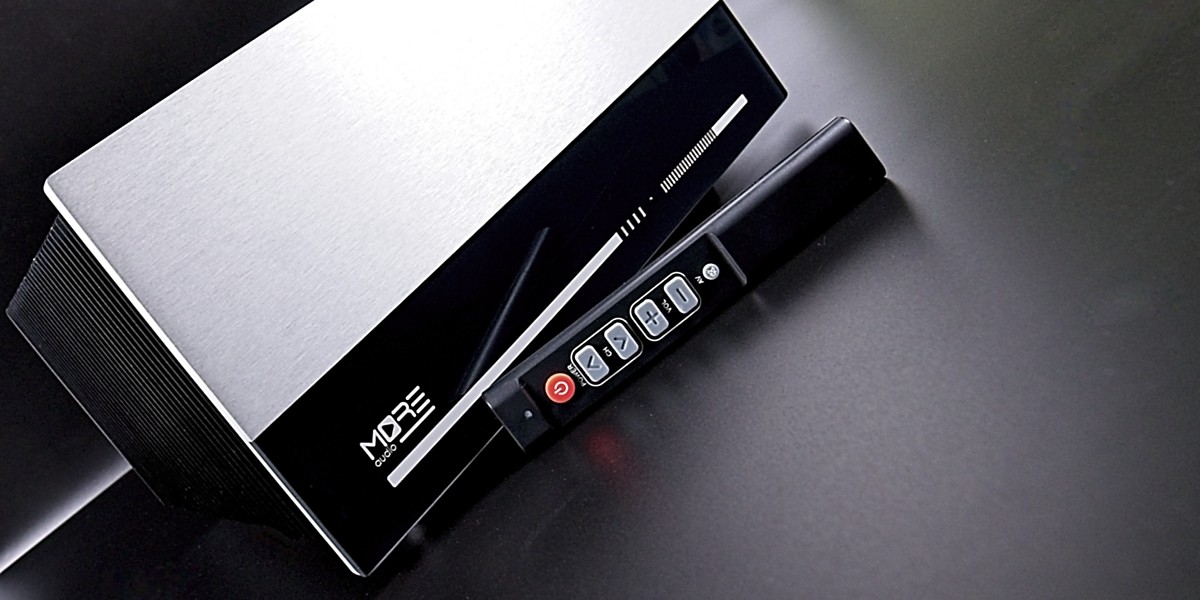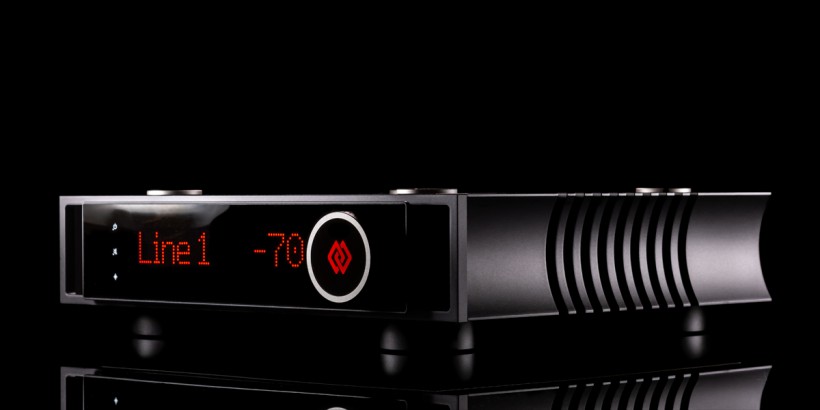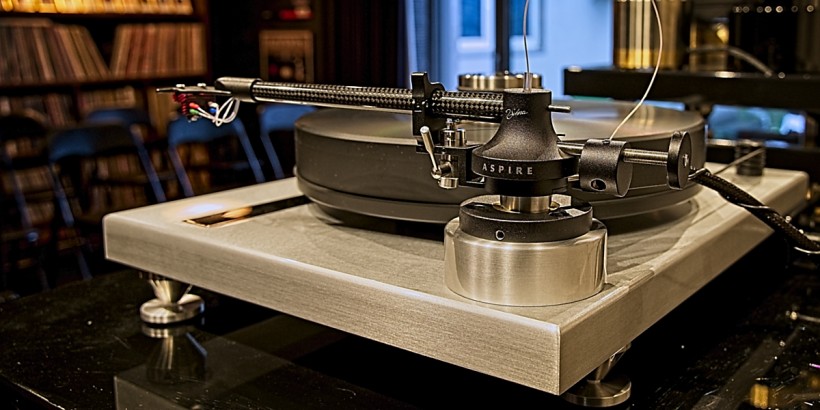Tomasz Kursa and I have known each other for years, so when someone like that tells me about “an exciting new Polish amplifier”, I take it seriously. Even more so, when soon after that I have the opportunity to meet the people behind the brand and get a taste of their amplifier’s performance at the Warsaw AVS 2024. Long story short, I just had to listen to MORE audio CS100 in my system. Let me share my findings from this experience with you.
Introduction
Only a short while ago, I tested a hybrid amplifier coming from my native region, Silesia, the OSV HT-50 (you can find the test HERE), and now I’ve had an opportunity to examine yet another interesting device from the same region of Poland. Sure, this whole hobby is (at least for me) about good sound and the best possible music presentation. Still, the sentiment of home region is probably something we all share, so the location of the manufacturer’s headquarters may have some importance, at least at the stage of getting to know the people behind it.
In this case, it was two gentlemen, at least one of whom I remembered from the DIY room at Warsaw AVS from the past, namely Jan Siwy and Tomasz Dębski. In 2024, however, in one of the rooms of the Radisson Blu Sobieski Hotel, their first commercial creation, the MORE audio CS100 amplifier, was driving a new version of the speakers of the aforementioned Tomasz Kursa, the AudioForm M200, which I first tested in 2018. It so happened that before the last year’s show I’d listened to a new version of these speakers, and yet another version, one taking into account few of my comments, was prepared for the show (I got them for another listening session after the AVS and can confirm that it is excellent!).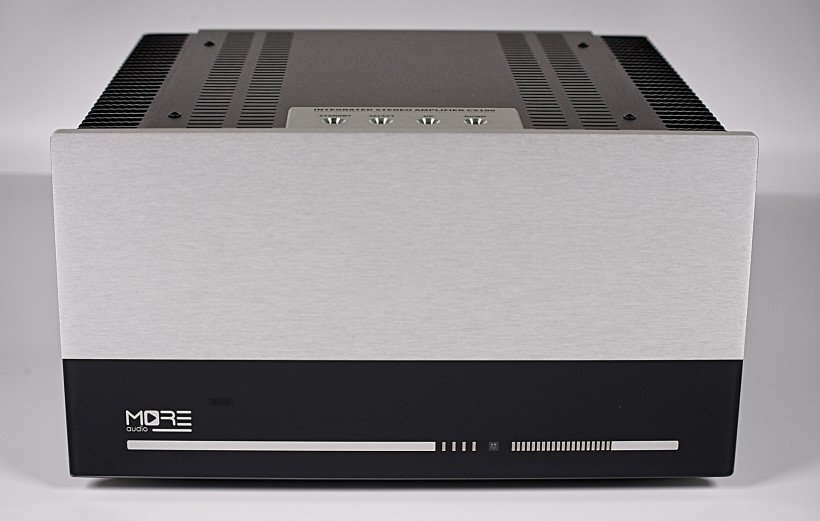
The system was complemented by other Made in Poland components, including the MuzgAudio DAC, as well as Perfect Connection cabling and a music server, and together the whole set sounded good. The setup was even more interesting for many people because the combined prices of all components (realistically speaking) seemed quite attractive considering the performance they produced. And since I’m always hungry for good products from our country, I told the gentlemen that More audio CS100 had to visit my listening room. They were kind enough to grant me my wish.
As this is a young brand that we are presenting at HiFiKnights.com for the first time, I asked the two gentlemen to introduce themselves and their company in their own words. Here is what they said:
Tomasz Dębski:
“From an early age, I was fascinated by both music and electronics, with a particular emphasis on the latter one for sound reproduction. Initial amateur designs, centered around effects and devices for guitars, and several years of experience playing the instrument, became a solid foundation for my later career path. Through frequent contact with instruments, I developed a precise perception of timbre and sonic nuances, which to this day makes it easier for me to assess the fidelity of reproduced music, especially in the context of Hi-Fi equipment.
Working at G-lab, where we designed effects and controllers for guitarists from around the world, was an extremely valuable lesson. Designing electronics working in the signal path before high-gain guitar amplifiers taught me about the necessity of absolute precision. Even the smallest design errors were immediately audible, forcing me to pay attention to every detail and focus on the uncompromising elimination of noise and interference. This attention to technical perfection went hand in hand with intentional shaping of the signal, including distortion, so important to the sound of the guitar. This experience taught me to design circuits that both distort and faithfully reproduce the signal. I think it was working on circuits of such different nature that allowed me to look at audio design from two complementary perspectives.
Parallel to my professional work, I was engaged in designing Hi-Fi amplifiers. Initially, while learning, I used existing schematics, but over time, I began to deviate from them, looking for my own innovative solutions. I experimented with various topologies, from hybrid designs to transistor circuits, striving for the cleanest and most natural sound possible. Over time, I realized that the key to success was to simplify the signal path while refining the circuit environment to ensure stability and predictable performance. These experiments also showed me that excellent amplifiers can be built based entirely on silicon, eliminating the drawbacks of tubes, such as the need to replace them after some time, high voltages, and parameter drift.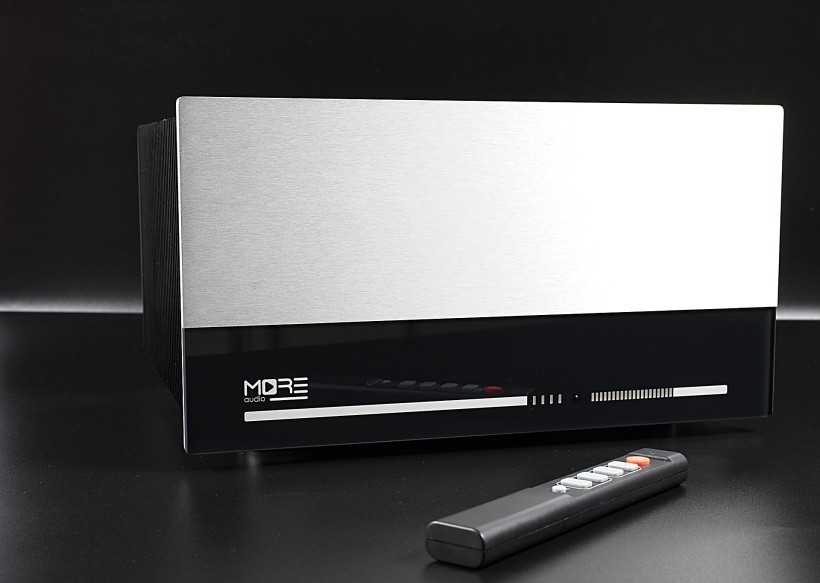
Some people tried to convince me to start my own company for years, but I was waiting for the right moment. It came in 2022, when the idea for a new, innovative topology was born. It resulted in such a unique amplifier that I decided to share it with others. After months of intensive work and a series of prototypes, we presented the MORE audio CS100 to the world in 2024. MORE is not just a name, it’s a philosophy. We strive to make music sound as full and natural as possible, believing that everyone deserves to experience its best and most beautiful side. It’s also a promise to constantly develop and explore new possibilities in the world of audio electronics. MORE is our mission.”
Jan Siwy:
“My story with music and electronics, or the road to MORE audio, began between 1987 and 1992, in my high school years. It was then, during a period full of discovery, that my passions and interests were formed, which influenced who I am today. My musical sensibility was greatly influenced by radio programs such as „Wieczór płytowy” hosted by Tomasz Szachowski and Marek Gaszynski. I remember the first musical fascinations, moments of deep experience of sounds – these were experiences that will be remembered for a lifetime. That’s when my love for music was born, which quickly merged with another passion for electronics and microprocessors. Even then, I enjoyed building, experimenting, and creating.
The choice of the field of study was obvious for me, so I attended the Faculty of Electronics of the Wroclaw University of Technology. Academic life had its priorities: a coffee maker and an… amplifier, which I built with my own hands and took to my dormitory. To put it half-jokingly, this amplifier and the powerful speakers that sometimes woke up my fellow students had a significant impact on my social life back then, and they have ever since. This device was not just a piece of equipment; it was a symbol of my ambition and creativity.
Shortly after university, I took a job as an electronics designer at a large manufacturing company. Our designs were used by thousands of users, but more importantly, it was there that I met Tomasz – my partner today. Tomasz worked on devices for the GLAB brand, and for twelve years, we created, learned, and developed together. After that time, our paths diverged for a while – Tomasz decided to return to designing, and I took on the role of R&D manager. However, fate wanted us to meet again and join forces at MORE audio.
For me, the foundation of the MORE audio brand is a fascinating return to the beginning – to youthful passions, love of music, and technology. Together with Tomasz, we use the years of gained experience, successes, and failures to create something unique. We create our equipment on our own terms, guided by both technological integrity and musicality – values that are the foundation of our brand’s DNA. For me, MORE audio is more than a company. It’s the realization of a vision and a return to what has always inspired me: the combination of engineering precision and true dedication to music. I believe that through the organic growth of our brand, we will show others how to do things well, authentically and with passion.”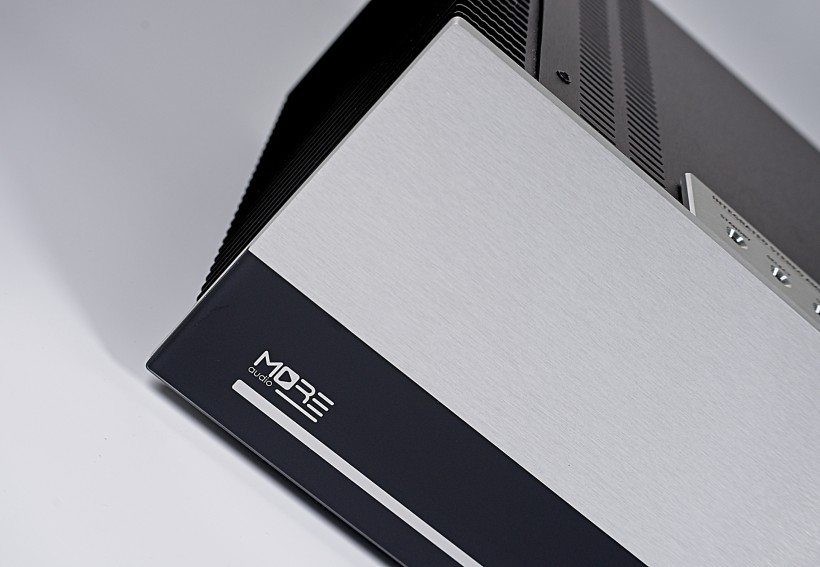
Design and Features
MORE audio CS100 is a ‘simple’ integrated amplifier. By ‘simple’ I mean ‘specialized’, developed to perform a single function, that of an integrated amplifier. You won’t find a DAC, streamer, phono preamp, Bluetooth, or headphone amplifier in it. It’s perhaps not so much a ‘simple’, but rather a ‘pure’ solid-state integrated amplifier, which additionally stands out from the majority of those available on the market due to its single-ended circuit. This device is not overly large, as it measures 340 x 180 x 330 mm while weighing 15 kg. At the same time, it offers as much as 100W of output per channel (@ 8Ω, and doubles this value @ 4Ω), so it is safe to assume it will manage to drive effortlessly most speakers available on the market. Its functionality is limited to four unbalanced line inputs (RCA), an input selector, and a volume control, both of which are operated either with buttons located on top of the chassis or with a remote control.
The front of the device is a silver-colored aluminum panel, although the lower part, up to about 1/3 of its height, is black glass. It features the company’s logo, as well as LED indicators of the active input and another quite unusual one for volume level. The inputs are numbered on the back, but on the front, they are represented by four red-lit (i.e., the one selected at the time) vertical indicators with no description. Reading the current volume level is not at all as simple as it might seem from the simple scale, which also consists of a row of consecutive (same size) vertical white dashes illuminated by red LEDs.
The point is that the volume scale is a two-part one. First, there are four dashes in the scale, and then separately a dozen more. When pushing volume up, the first one of these four lights up, and to the right in the longer row, more LEDs light up. When the last one lights up, the second dash in the first row lights up, and the longer row starts to illuminate again from the beginning. And so four times, if one gets that far with the volume (which in practice is unlikely to happen). As one of the creators of the CS100 told me, the idea for this solution came from a mundane reason, i.e., there was not enough space on the front to realize such an indicator ‘in its entirety’, because it would have to take up the entire width of the baffle. So it was simpler to decide on a variant where the scale reaches the end, and then jumps to a ‘higher’ gear and starts from the beginning.
Let’s get back to the chassis. It is made entirely of aluminum, but most of the elements, except for the front panel, are painted black. This applies to the solid notched heat sinks on both sides, as well as the rear panel. The amplifier’s cover features several holes, which further improve ventilation inside the unit. The aforementioned physical buttons are recessed into an aluminum plate centrally located on the top surface of the amplifier near its front edge. The manufacturer has opted for good-quality Neutrik professional-series RCA jacks, and the speaker jacks come from CMC. The included remote control is admittedly a unit made of plastic, but it’s slim, handy, features large buttons, and really doesn’t look bad. I know of many, much more expensive audio products that come with decidedly inferior-looking and made remotes. In this case, I for one will not complain about the plastic.
Looking inside, you’ll see that the preamplifier section, in the form of the input selector and volume control, has been mounted directly behind the input jacks, which shortens the signal path to a minimum. The input selector uses high-end analog switches. As MORE audio’s designers told me, the advantage of this approach over relay solutions is that it further improves the quality of the signal path in terms of reducing parasitic capacitances and connection inductance.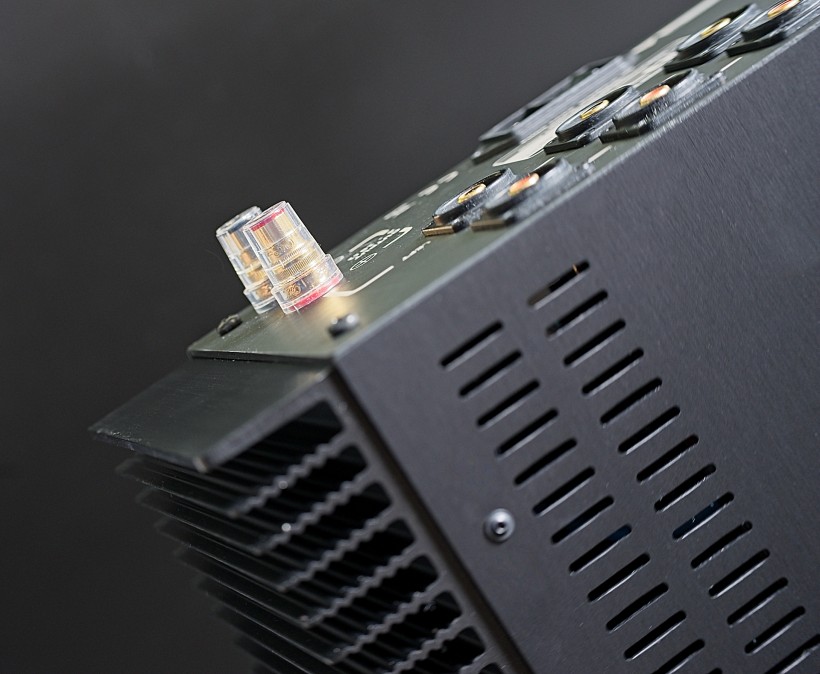
The next stage of the amplifier is an input buffer that provides a high input impedance of 100 kOhm. Such a high constant impedance does not load the signal sources regardless of the quality of their output buffers. An additional advantage is the isolation of the next preamplifier stage. Mr. Tomasz and Mr. Jan emphasized in a conversation with me how much research work they devoted to volume control. After testing, they rejected off-the-shelf solutions (integrated circuits) due to too much distortion. In the end, the CS100 uses a resistor ladder switched with high-end analog switches. This solution ensures very low distortion over the entire attenuation range. The attenuator operates in the range from 0 to -64dB in 64 1 dB steps.
The last stage of the preamplifier is the output buffer. Its high input impedance does not load the volume control, and its low output impedance has made it possible to simplify the next stage, the voltage amplifier. The gain of this stage is 36dB, resulting in an input sensitivity of 600 mVpp for a volume control set to 0 dB. This high sensitivity, combined with a wide range of attenuation control, allows the CS100 to work with a variety of sources with a wide range of output voltages.
The last stage is a current buffer. Like all other stages, it is built in a SE (single-ended) topology. Thanks to a special design, it operates in class AB with a relatively low bias. This is supposed to make the amplifier more power efficient, and as a result, it can be significantly smaller than pure Class A devices. The designers also placed special emphasis on stabilizing the operating point of the final transistors. The bias for them is maintained with 5% accuracy. In the final stage, there are two local positive and negative feedback loops. This results in an effectively negative output impedance. This means that under load, the output signal does not decrease, but gently increases. This solution provides much better speaker control than classical designs.
The amplifier does not use a global negative feedback loop, only local feedback in individual circuits. It is not a dual mono design, but the channels are fully separated, and the common point is located in the power supply. The latter is built around a high-end 400VA toroidal transformer. It also uses filter capacitors with a total capacity of 88,000 uF. Control of the amplifier is handled by a chip with a microprocessor that monitors the correctness of voltages, controls the power on/off sequence, preamplifier circuits, and front panel LEDs, and receives a signal from the IR remote control. To isolate it from the amplifier circuits, its power is handled by a separate transformer-based power supply.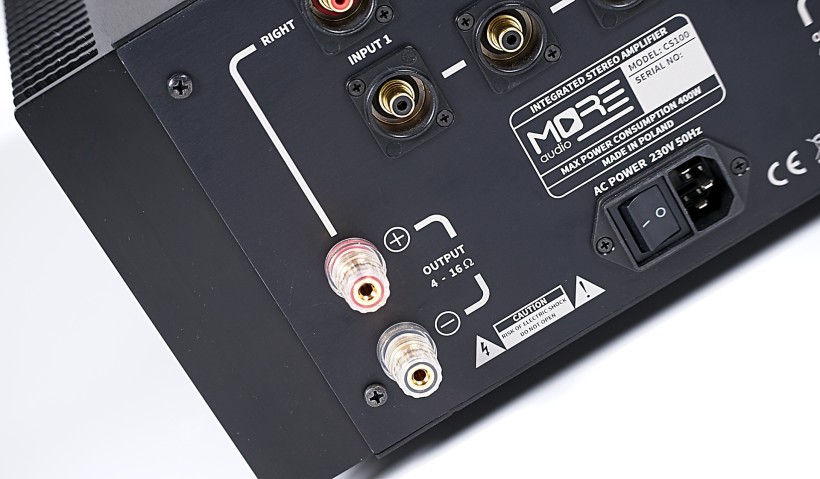
The entire signal path is fully discrete and is built using bipolar transistors, and only in the output do they use MOSFETs. The amplifier board is a custom design in which the transistors are not mounted on the edge, but in the center, which reduces the length of the signal path to a minimum. The power amplifier boards are designed as symmetrical (left and right channels separately), although the designers made sure that they are mirror images.
In addition to the aforementioned remote control, the amplifier comes with a power cable made of high-quality cable by LAPP. The amplifier is delivered in a dedicated, sturdy metal and wood box, which guarantees the safety of the device during transportation.
Sound
Although the MORE audio CS100 integrated amplifier was delivered to my place straight from the Warsaw Audio Video Show 2024, it had to wait quite a long time for its turn, as I had to deal with other non-audio-related matters. So when I was finally able to sit down to listen to it, there was a lot going on in my system, partly because of the month-long review backlog, and partly because of some (cumulative for the same reasons) changes that had been newly introduced to it. These changes included, first of all, the swap of my trusted turntable. I emphasize the use of the word ‘swap’ as my J.Sikora Standard Max, which I had been using for years, which was one of the first production units and thus had been upgraded several times over the years, was replaced by a unit from the current production. Theoretically, it’s the same turntable (although now black, not silver), with the same tonearms and cartridges (professionally installed and set up by the fantastic J.Sikora team!), but there are some minor differences in the design compared to the one I had before. Hence, I had to get used to it before using it to assess other components.
The second (for now considered ‘potential’) change occurred on the eve of starting serious listening of the CS100. I was missing a balanced source in my system, so I started discussions with LampizatOr (because I love my Pacific 2!) about a possible replacement of my SE version with a balanced one. To begin with, however, I got the newer model, Poseidon, for listening and testing, but the Pacific 2 SE stayed with me for now as well. So while listening to the MORE audio CS100 amplifier, I alternated between the two.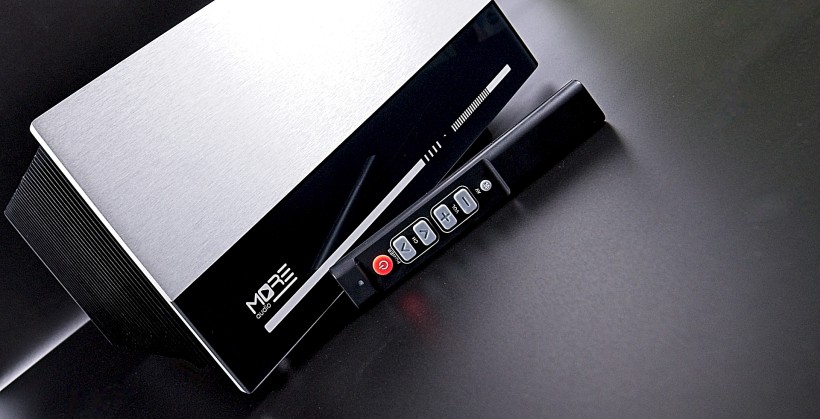 Last but not least, given the high output of the tested integrated, instead of the MACH 4s as main speakers in this test, I used my other pair, Ubiq Audio Model One Duelund Edition, which are large, 3-way closed-box floor-standers, certainly more demanding for amplifiers than the GrandiNote. Having explained the changes in my reference system, let me finally move on to the listening experience.
Last but not least, given the high output of the tested integrated, instead of the MACH 4s as main speakers in this test, I used my other pair, Ubiq Audio Model One Duelund Edition, which are large, 3-way closed-box floor-standers, certainly more demanding for amplifiers than the GrandiNote. Having explained the changes in my reference system, let me finally move on to the listening experience.
The original design of the MORE audio CS100 with a current buffer operating in a single-ended, AB class circuit, as much as 100 watts of output per channel (@ 8Ω), and my first experience with the amplifier at AVS 2024, all indicated an interesting experience ahead of me. Although the CS100 does not belong to the category of huge and super-powerful amplifiers, the aforementioned relatively high output made me wonder whether I should expect a powerful, perhaps somewhat offensive sound (although I experienced nothing of the sort during the presentation at the Radisson Blu Sobieski Hotel).
I needed just a few minutes to be sure that it was not that kind of amplifier. Effortlessness – sure, great speaker control – yes, a powerful slam and great bass extension (when needed) – absolutely. It was also clear from the outset that this integrated provided a dense sound, slightly warm, deeply saturated, even across the whole band, and rich in information and details, even the tiniest ones. To put it another way, it was full and refined presentation, thus reminding me of good tube amps and Class A solid-states, rather than powerful AB Class transistors, some of which (admittedly less and less of them in recent years) are overly focused on clarity, flexing (whether needed or not) of muscles, and sometimes super-detailed/hyper-transparent presentation of recordings (rather than music).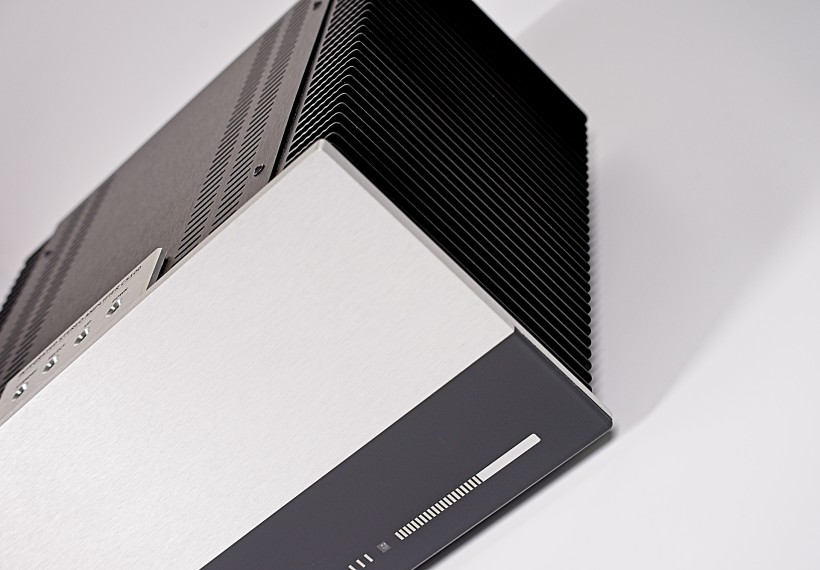
Knowing that it’s a single-ended circuit, albeit a transistor one, based on experience, I could expect (at least to some extent) this kind of performance. That is, an effortless (I’m repeating myself, but it’s not that common a characteristic at all), open, full of air sound, with reverberation and decay (in recordings where they occur, of course) playing a significant role, and above-average three-dimensional imaging. Let’s add to this list another feature important for the realism of the presentation, namely the ability to convincingly render the acoustics of recordings and venues. Because this is where transistors can never quite match the best tube SETs, but some, including the MORE audio CS100, come close.
It’s no secret that it’s the tangibility and ‘presence’ of the performance that are among the qualities I love SETs for most, and that I look for, with or without success, in all tested devices, regardless of the technology. So when, especially in live recordings, I heard and felt the acoustic environment rendered precisely and convincingly in front of me, and sometimes almost around me, my initial enthusiasm for the tested device increased even more. Such an effect, or simply tapping into the greatest advantages of tube designs, is achieved by designers in various ways, most often by creating hybrid designs (vide the Circle Labs, Tenor Audio, or OSV amplifiers already mentioned).
Only a few, here GrandiNote, Pass, and now MORE audio come to mind first, can achieve such a convincing recreation of recordings’ acoustics with the help of silicon alone. And kudos to them for that. After all, there is no shortage of music lovers who love the sound of tubes, but for one reason or another, do not want to use them in their room. In my opinion, it is primarily for them, but also for all other music lovers, especially those for whom “live” music is the primary source of reference, that MORE audio developed its first amplifier.
MORE audio CS100 integrated in a blind test would probably be able to ‘fool’ many music lovers by creating a beautifully three-dimensional, immersive, very ‘present’ musical experience, in which reverberations, decay, and other elements that make up the acoustics of recordings play a big role. That’s what makes the tested amplifier’s sound quite ‘tube-like’. Of course, depending on the type of music (but also the driven speakers and the size of the room), there would also be features indicating very good speaker control and high power, suggesting transistors in the circuit. Nevertheless, at least for me, these conventionally ‘tube’ qualities were more important at this stage of the experience.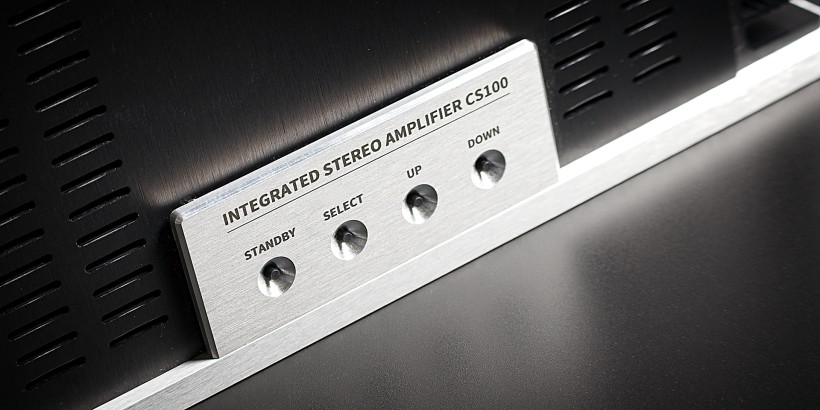
The MORE audio CS100, however, sounds neither like a typical tube, nor like a typical powerful solid-state, because even the low, powerful bass is by no means super-tight, it is not overly, and certainly not artificially contoured, but rather dense, colorful, slightly warm and a bit round, but at the same time very well differentiated. This roundness and ‘warmth’ are within the limits of a natural sound, having nothing to do with coloration. That’s why the double basses, whether played by Christian McBride, Frédéric Alarie, Ray Brown, or Stanley Clarke, which I listened to for a really long time, sounded so great. They were powerful, extended very low, had just the right tightness and speed, but were not dry, not artificially contoured, nor dull. They enchanted me with the natural timbre, power, and depth of sound, in ‘live’ recordings, also with the almost palpable ‘presence’ of a large instrument’s ‘body’, reminding me (again) of performances delivered by some very good tube amplifiers.
But when, after the “double bass” stage of my tests, I reached for the performances of bass guitarists (electric, to be clear), i.e. albums with performances of Marcus Miller, Victor Wooten, or Jaco Pastorius, the tested amplifier also excelled in rendering fast, hard “kicks”, or amplified, very low, saturated to the limit slams. At the same time, it maintained very good differentiation, which ensured the full experience of the showdown of each of the masters of this instrument. Yet another excellent feature of this amplifier, namely great PRAT (pace, rhythm, and timing), was impossible to ignore as well, as the MORE audio CS100 did a great job also in this regard.
The so-called PRAT had been flawlessly presented before I got to bass guitar masters, but I’d just accepted it as a natural thing without paying much attention to it. Now, constantly nodding my head and tapping out the rhythm with all my limbs, I finally realized how well the CS100 handles this aspect of music as well. I got yet another confirmation when listening to the next, excellent album, Tadeusz Nalepa’s „Najstarszy zawód świata” (“The Oldest Profession in the World”), where, in addition to showing how well MORE audio CS100 feels the blues, I listened with excitement to the seemingly ordinary, but in fact extraordinary Nalepa’s voice, his beautifully sounding, highly expressive guitar, but also, among others, very realistically sounding Hammonds.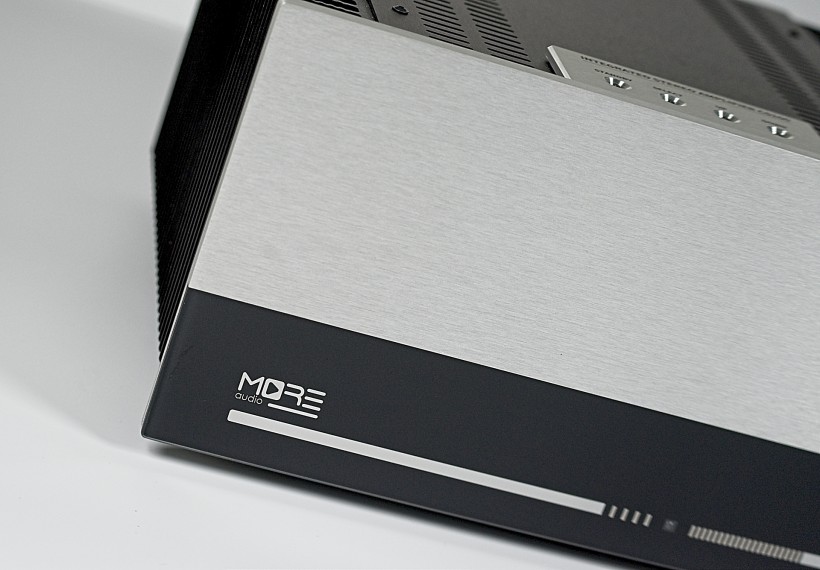
As I continued my adventures with female and male vocals from various genres, blues, jazz, rock, and eventually also opera, I wondered why they sounded so familiar and so good at the same time. It took me a while, but I finally came to the obvious conclusion that what I liked so much was the very ‘tube-like’ naturalness of their sound. ‘Tube-like’ means more like a low-output SET, not a powerful push-pull amplifier. In this sound, there was not only smoothness, density, and natural warmth, but also a touch of sweetness combined with clarity and sonority (full, not jazzy) audible in the upper range.
This presentation was tangible and present, as I’d mentioned before, but at the same time relaxed, free of fatigue even after many hours of listening. The MORE audio CS100 integrated differentiated recordings very well, extracting a tremendous amount of information from the best recordings and using them to deliver pure, well-arranged, engaging musical performances, but it didn’t butcher the inferior ones. In a word, this is not an amplifier that can be used for listening only to the best productions and releases, but it will let you experience any good, decently recorded music in a very satisfying way.
It was only when the assessment was coming to an end, after several switch-ons that happened at least once a day, that I realized that the MORE audio CS100 shares another characteristic with tube and solid-state Class A amplifiers. Namely, it needs some time to warm up before it delivers its optimal performance. It doesn’t take particularly long, 20 minutes or so is enough, these are not big changes, and mainly concern the already mentioned effortlessness and spatial aspects of the presentation, and maybe a little bit of upper band opening, but they are there every time, and they are changes for the (even) better.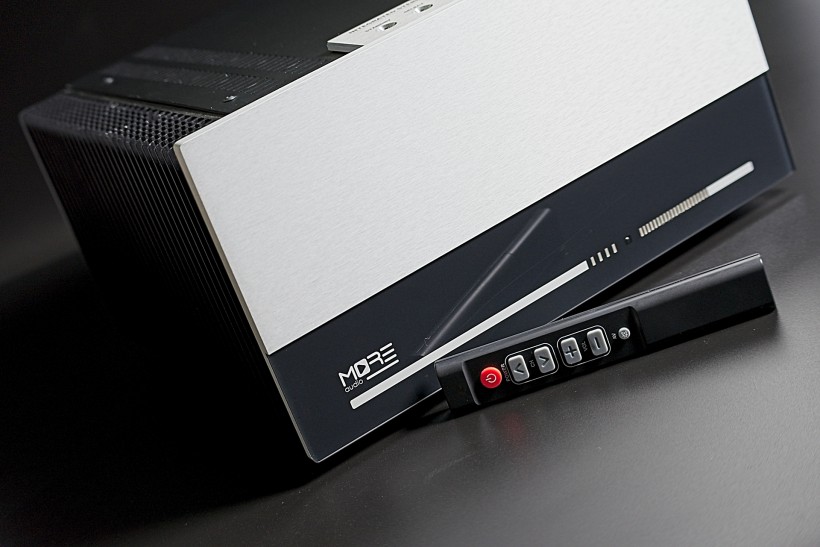
It seemed to me already on the first day with the Polish integrated, and subsequent sessions reinforced this conviction, that this is an amplifier that shows its full potential in slightly longer listening sessions rather than making a huge first impression of five minutes. Interestingly, even after several hours of intense, sometimes quite loud playing, it hardly got warm (although with significantly more difficult to drive loudspeakers, this may not be the case), which is not what I could say about similarly (to a point) sounding SET or solid-state Class A cousins. It may be yet another of its qualities that will make it even more irresistible to some potential users.
Summary
MORE audio CS100 is an unusual and very special amplifier. First of all, it’s a matter of design, because solid-state single-ended circuits (that is, with a single signal-amplifying element in the output stage) are virtually non-existent on the market – that’s the domain of tubes. Secondly, and really most importantly, on the one hand it’s a small ‘powerhouse’ perfectly controlling the reproduction of any kind of music, at any volume level, even loaded with sizable 3-way closed-box speakers, on the other it is not about a raw power, but using it for refinement and elegance of the presentation. As a result, CS100 delivers an exceptionally relaxed, yet dynamic, and energetic, and on top of that also palpable, natural, and refined sound.
The exceptional spatiality, tangibility, three-dimensionality, and in some recordings (because, after all, it also depends on them) even the feeling of the ‘presence’ of the performers in my room reminded me of what I love SET amplifiers for. The latter, however, require quite specific speakers, and there are not that many of those on the market, to let the SETs perform at their best. MORE audio CS100 requires from the speakers to ‘only’ keep up with its lead, to be good enough to show its full class. Obviously, a high-end source is a prerequisite because without a good signal, no amplifier will be able to deliver a good performance.
This is a great performer, a fantastic value for the money, and really hard to beat at its price. Finding a decent competition from well-known brands will send you to a distinctly higher price shelf. Give it a try, as it is, next to the OSV HT-50, one of the best and most interesting non-particularly expensive amplifiers I’ve had the opportunity to listen to in a long time.
Price (when reviewed):
- MORE audio CS100: 4.900 EUR
Manufacturer: MORE AUDIO
Technical specifications (according to the manufacturer):
- Input sensitivity: 600 mVpp
- Input impedance: 100 kΩ
- Inputs: 4 x RCA unbalanced
- Volume control: 0 dB to -64 dB ( in 1 dB steps)
- Frequency range: 5Hz – 120kHz (-1 dB)
- THD+N: 0,05%
- Output: 100W RMS / 8Ω, 200W RMS / 4Ω
- Output impedance: –150 mΩ
- Weight: 15 kg
- Dimensions: (W x H x D) 340 mm x 180 mm x 330 mm
- Box dimensions: (W x H x D) 382 mm x 252 mm x 453 mm
Associated equipment:
- Digital source: a custom passive server with WIN10, Roon, Fidelizer Pro 7.10, JCAT NET XE, and JCAT USB XE cards with FERRUM HYPSOS Signature power supply, KECES P8 (mono) linear power supply for the server, JCAT USB Isolator
- D/A Converter: LampizatOr Pacific 2 +Ideon Audio 3R Master Time (USB signal regenerator)
- Analog front end: J.Sikora Standard MAX turntable, J.Sikora KV12 & J.Sikora KV12 MAX tonearms, AirTight PC-3, Audio Technica PTG33 Prestige & LE SON LS10 MKII cartridges, Grandinote Celio MK IV & ESE Lab Nibiru V 5 phono stages.
- Power amplifiers: GrandiNote Shinai, Circle Labs M200, Art Audio Symphony II (modified)
- Preamplifier: Circle Labs P300
- Loudspeakers: GrandiNote MACH4, Ubiq Audio Model ONE Duelund Edition.
- Interconnects: Bastanis Imperial x2, Soyaton Benchmark, Hijiri Million, Hijiri HCI-20, TelluriumQ Ultra Black, KBL Sound Himalaya 2 XLR, David Laboga Expression Emerald USB, David Laboga Digital Sound Wave Sapphire Ethernet
- Speaker cables: Soyaton Benchmark Mk2
- Power cables: DL Custom Audio 3D-S-AC Connect, LessLoss DFPC Signature, Gigawatt LC-3
- Power: Gigawatt PF-2 MK2 and Gigawatt PC-3 SE Evo+; a custom power line with Gigawatt LC-Y in-wall cable; Gigawatt G-044 Schuko and Furutech FT-SWS-D (R)
- Network: Silent Angel Bonn N8 + Silent Angel Forester F1 + optical LAN isolator
- Racks: Base VI, Rogoz Audio 3RP3/BBS
- Anti-vibration accessories: ROGOZ-AUDIO SMO40 and CPPB16 platforms and ROGOZ AUDIO BW40MKII feet, OMEX Symphony 3S, Franc Accessories Ceramic Disc Slim Feet and Wood Block Platform, Graphite Audio CIS-35 and IC-35 Premium


